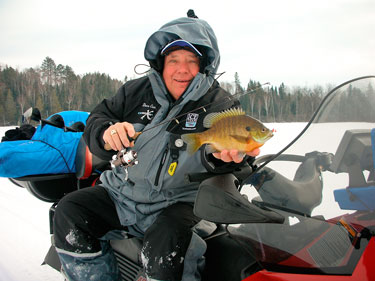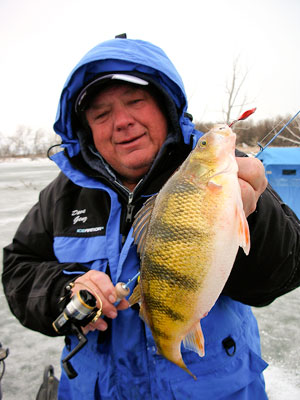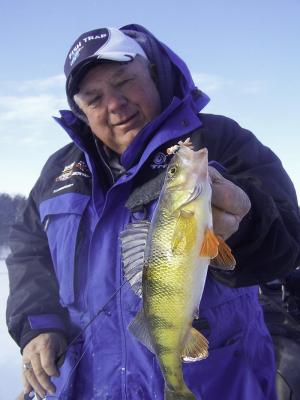When you pull up to the lake, you should know what you’re going to do first. And what you’re going to do next if it doesn’t work.
How to make a plan, execute it, and change it on the fly.
 Frozen lakes are not easy to catch fish from if you simply head out onto them without a plan.
Frozen lakes are not easy to catch fish from if you simply head out onto them without a plan.
Planning each day on the ice is an aspect of modern ice fishing that many–maybe most–people overlook. Yet, after all these years of refining the system he pioneered, Dave Genz has come to appreciate “the plan” as one of the most important pieces of the puzzle.
“You can have every piece of equipment, and know how to use it,” begins Genz, “and you can still strike out if you just go out there without an idea of what you’re going to do.”
Gathering Info
You don’t have to become a library rat in order to catch more fish, but it helps to spend time learning about the lake (or lakes) you’ll be fishing. Genz is a computer user, and you should be, too. He looks up information about lakes, starting with state or provincial agency web sites.
“Learn about the size of the lake, water clarity, whether it usually has good weed growth, and what fish it has,” says Dave. “You should fish for the dominant species in the lake. If you want to go perch fishing, go to a lake that has a good perch population.”
Dave has long appreciated the value of talking with fellow anglers, too, and listening to their reports. He and his friends who developed the Winter Fishing System talk about “chasing the best rumors,” which Dave enjoys doing.
Rumors fly, of course, on web chat rooms, so it’s not hard to find rumors to chase.
Gearing Up
 It’s a sin to hit the ice without having your gear ready to fish with. You might be able to get away with that in the summer, because you can let the boat drift while you tie knots or tighten the trolling motor. But in the winter, working on equipment is much harder.
It’s a sin to hit the ice without having your gear ready to fish with. You might be able to get away with that in the summer, because you can let the boat drift while you tie knots or tighten the trolling motor. But in the winter, working on equipment is much harder.
Genz always rigs rods the night before, with several lures that he wants to try. He charges all batteries, dries out and warms up his Vexilar, heater, propane, cleans and refuels his StrikeMaster auger, on down the line. Often, when he’s staying in a hotel, he brings his Fish Trap in the room and organizes it.
“I like to have horizontal and vertical jigs tied on to rods,” he says. “Depending on what I’m fishing for, it might be the Genz Worm, Fat Boy, Genz Bug, Rattl’n Flyer Spoon, Slick Jig, or the Lindy Darter. I want to be able to show the fish something different without having to re-tie.
“When I’m out on the ice, I want to fish, not get ready.”
Executing the Plan
When your fingers and toes are cold and the wind is blowing, great ice-fishing plans get replaced by how good it feels to crank up the heater and hunker down inside a Fish Trap. It’s important, Genz stresses, to set your mind in plan mode before you get on the ice.
“It can be hard to execute the plan,” he says. “You’re going to do this and that, and then you get overwhelmed by how deep the snow is. You have spots you want to check out, but there are no tracks going to them. Your truck or ATV gets stuck, and it becomes easy to think of reasons not to do it. We have to be well equipped to do the things we want to do.”
In heavy snow, Genz relies on a Bearcat (Arctic Cat) snowmobile to get him from spot to spot. He is impressed by track systems available for ATVs, which allow them to move along the top of deep snow.
“I find myself talking about equipment,” says Dave, “but there’s no way around it. In order to break the trail and go searching for fish, you have to have the stuff.”
Lake maps are a huge deal. He still uses paper maps, but in most cases, he uses digital contour maps on a GPS unit. “I use LakeMaster chips,” says Genz. “They’re one of the biggest breakthroughs in recent years. They make the search much easier than it was in the old days. You can check spots in minutes instead of hours. You can drive right up to the sunken island, or the base of the break, and follow it accurately. Your first hole is right where you want it.”
Adjusting on the Fly
 Assuming you execute the plan but don’t catch much, it’s time to make adjustments on the fly.
Assuming you execute the plan but don’t catch much, it’s time to make adjustments on the fly.
Genz recounts a story from Devils Lake, North Dakota. He and his buddies had it on good authority that big perch were going good in a certain bay. “We all got on our machines and headed out, straight to the pack of people. That’s a good place to start. We talked to them, and they all had stories about how good the fishing was, but now they quit biting.
“We drilled some holes in the area, and there just weren’t many fish around. We knew from experience that the perch had moved. They didn’t quit biting. They just weren’t there anymore.
“There were four of us fishing together, so we picked a direction and broadened our search away from where the people were. We started leapfrogging each other, checking new areas maybe a hundred yards apart (you may have heard about Genz’s concept of football fields and tennis courts; this was the football fields part). Suddenly one of our guys caught a perch.
“Now we know we’re getting closer. We all came together in that area and started drilling holes closer together (this is the ‘tennis courts’ part). Eventually, we got onto an area where every time you dropped down groups of perch would rise three feet off the bottom to come up for your bait. We were maybe a half-mile from where the people were. We settled in and caught lots of fish. We had to drill a lot of holes and keep moving to get to that point, but it was well worth it.”
You can do this same thing in your own fishing.
“You just have to keep looking,” says Dave. “Sometimes, you have to go down a breakline, along the base (drilling holes where the dropoff levels off in deeper water). Again, you can follow these things with a good GPS and a map chip. You don’t have to find every fish in the lake. Just find some fish that you can catch.
“I enjoy the act of fishing, and figuring it out. It’s exciting, to me, to find fish on the Vexilar. I’ve said this before, but my favorite fish are red lines on my Vexilar (fish that are directly under you show up as red lines). I’m not fussy about what they are.”
He is, however, impatient, and executing a plan, until he finds those red lines.
Note: Dave Genz, known as Mr. Ice Fishing, was the primary driver of the modern ice fishing revolution. He has been enshrined in the National Fresh Water Fishing Hall of Fame and Minnesota Fishing Hall of Fame for his contributions to the sport. For more fishing tips, go to www.davegenz.com.










